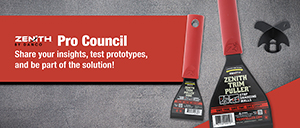
The kitchen is one of the busiest places in the house. It’s not just for cooking. It’s also where most families share meals and can be an extension of the living and entertaining space. No wonder it’s known as the heart of the home. If you are not quite happy with your current kitchen, it might be time to upgrade it. This doesn’t necessarily mean doing a complete overhaul. Simply replacing your kitchen countertops can already make a big difference in the overall look and feel of the space. Don’t worry, this should be an easy DIY project when you use high-quality Zenith tools!
How to remove countertops
Kitchen counters are typically attached to cabinets using a combination of screws and adhesives. Some installations such as granite may involve an adhesive like epoxy, which can make removing them more challenging. Laminate countertops are straightforward to remove.
No matter what kind of countertops you have, this guide will help you remove them easily.
Remove the backsplash
Kitchen countertops are built with two parts: the backsplash and the counter. Use the Zenith Floor Lifter to pry off the backsplash. It’s a tool that’s designed to simplify backsplash and trim removal without damaging the drywall underneath. It has a ground level on the Floor Lifter’s edge, so it can be driven easily between the tool and the wall to release the seal. Extraction is made easy by the unique wedged center, which is designed so that it doesn’t damage the panel or the wall.
Place the Zenith Floor Lifter between the backsplash and the wall to break the adhesive seal. Start at one end, then work your way down while removing the trim. Drive the floor lifter at one end of the backsplash, then pull until it’s completely separated from the wall.
Be gentle to avoid snapping the backsplash, and beware of any nails stuck to the board.
You can also use the Floor Lifter to remove vinyl or wooden siding, wood and tile flooring, oversized boards, planks, and carpet tack. You can find the Floor Lifter at the Home Depot and on Amazon.
How to remove countertops
Remove all unnecessary items from the cabinets, including appliances, cookware, sink, and drawers. Then, locate the screws that are holding the countertops onto the cabinets. With a screwdriver or drill, you can easily loosen and extract those screws.
A silicone sealant is often used for kitchen countertop installation. You need to break the adhesive so you can remove the countertops. If you have a smaller counter area, the Trim Puller will be useful in gently destroying the adhesive bond. Simply place the tool in the seam between the cabinet counter, tap gently with a hammer, and work your way to remove the seal.
Given their size, countertops require a bigger tool for removal without damaging them. In that case, use the Zenith Trim Puller for that. It has an integrative center wedge that makes removal more efficient and less likely to cause damage. It’s easy to use the Trim Puller. Just insert it between the cabinet and the counter and then pry along the cabinet’s length. Lift the countertop until it’s completely removed.
You can shop the Trim Puller on the Home Depot, Lowes, and Amazon.
After removing your old countertops, you can now install the new countertops!




